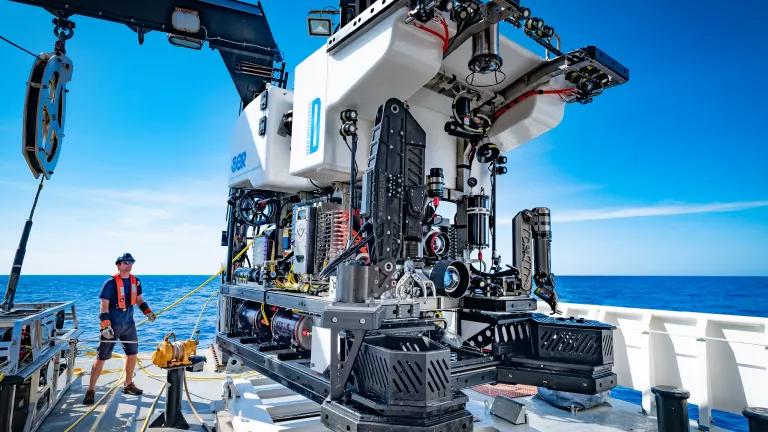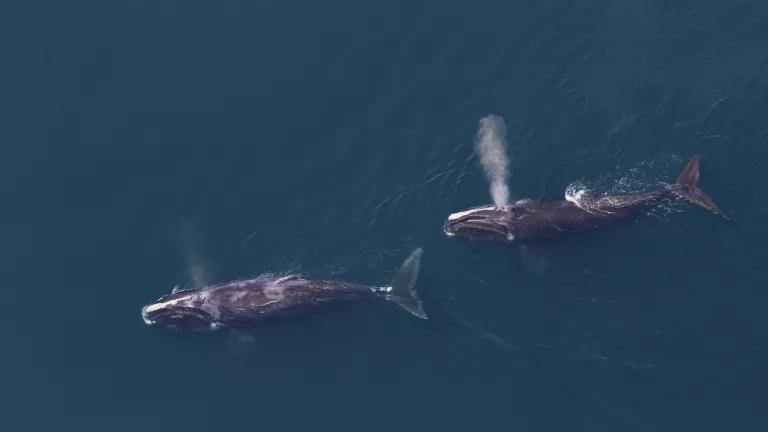Tomorrow in Providence I’ll Testify that a National Policy Can Help Protect the Atlantic Coast
As a child, my summer revolved around my family's week-long vacation to Cape Cod. My brother and I loved jumping in the waves, searching for beach glass along the shore, and threading small shells together into necklaces that my grandmother would actually wear. I took for granted having a clean beach to play on and the fresh seafood we ate. The ocean was so vast - it seemed capable of handling anything that was thrown at (or into) it. But that's not the case.
Worldwide, our oceans are under enormous strain as a result of overexploitation, habitat degradation, coastal pollution and climate change. Globally, 80 percent of the world's fish stocks are either fully exploited or overexploited and highly migratory species of large tunas, marlin and sharks have declined by as much as 90 percent in some regions. Stormwater runoff from streets and nutrient-laden fertilized lawns contributed to two-thirds of the U.S. beach closing/ advisory days in the 2008 beach season. Ocean waters are turning increasingly acidic from their intake of carbon dioxide: average surface ocean pH has already decreased by about 0.1 units in seawater pH compared to preindustrial levels, equivalent to a 30 percent increase in acidity. A more acidic ocean could wipe out species, disrupt the food web and impact fishing, tourism and other jobs that rely on healthy seas.
One major obstacle to protecting our marine and Great Lakes wildlife and ecosystems is the fact that these resources are currently governed by a mix of more than 140 laws and 20 different agencies, each with different goals and with no single unifying conservation mandate. We have a Clean Water Act for our water and a Clean Air Act for our air; we need a national policy to similarly protect our oceans, coasts, and Great Lakes.
In June, President Obama called together an interagency Ocean Policy Task Force to fix this problem. The 23-member federal Task Force is directed to create a unifying oceans, coasts, and Great Lakes policy and design an effective marine spatial planning framework in 180 days. This Thursday, I'll be at the Ocean Policy Task Force's public hearing in Providence, R.I., with my colleague Sarah Chasis, to talk about why President Obama should issue an Executive Order formally establishing a national oceans, coasts, and Great Lakes policy to protect, maintain, and restore the health of these valuable ecosystems.
The Atlantic Coast's underwater canyons are a great example of why this kind of national overarching policy is needed. A series of ancient submarine canyons line the continental shelf offshore, under the waves, from Massachusetts to Virginia. The canyons plummet down several miles and their solid undersea walls, combined with the fact that fast flowing currents carry in microscopic food and remove waste from the canyons, make these areas oases for an astonishing diversity and abundance of animals - from various species of flounder, hakes, and skates to American lobster, colorful corals, sponges, and anemones. Endangered sperm whales, beaked whales, dolphins, and other marine mammals come to the canyons to feed on the schools of squid and fish that congregate there.
But these remote sanctuaries are in danger of irreversible damage from advanced fishing technologies and renewed oil and gas exploration. Bottom trawling technology advances are making it increasingly possible to fish challenging seafloor landscapes like the canyons as commercial fishing enterprises seek out new populations or species to catch. Trawling nets stretching up to 40 meters in width and held open by pairs of seven-ton steel trawl doors crush or rip out habitat as they are dragged along the seafloor, removing in a few brief acts what took nature centuries to build and leaving bare, scarred sand, mud and rock where corals and abundant sponges once were. The canyons also need protection from oil and gas exploration and development. Between 1959 and 1983 dozens of exploratory oil and gas wells were drilled in or near several major submarine canyons off the Atlantic continental shelf. Until recently, the Atlantic Coast was protected from oil and gas drilling by Presidential and Congressional actions, but during the Bush Administration these measures were removed and new oil and gas exploration, including drilling and seismic surveys, would introduce significant oil, toxics, and sound pollution into the canyons.
With our haphazard system of laws and agencies in control of ocean resources there's no way to address simultaneously both the problems posed by bottom trawling and oil and gas exploration and drilling. Offshore energy issues are the purview of the Department of the Interior, while the regional fisheries councils and the National Oceanic and Atmospheric Administration address fisheries issues.
Without being able to tackle both challenges at the same time we run the risk of the situation that is playing out right now in South Carolina. The South Atlantic Fishery Management Council is trying to protect from destructive fishing gear a remarkable 23,000-square-mile forest of coral reefs that stretches from North Carolina to Florida. Simultaneously, a South Carolina feasibility study committee set up by the state legislature has been looking at where exploratory drilling should occur off the coast - in this same coral landscape.
A national policy to protect and restore our oceans, coasts, and Great Lakes would establish a unified, underlying structure for addressing such issues. Additionally, protecting the submarine canyons from bottom trawling and oil and gas development would be a prime early initiative that would help translate the new national policy into action.
Join me in sending your support for a national policy for healthy oceans by taking action here.




